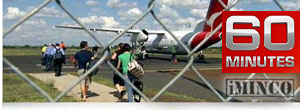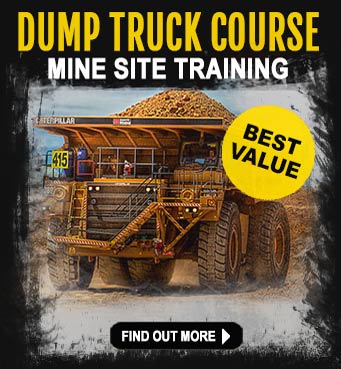 Liam Bartlett of 60 Minutes reported on the current state of the industry in an informative and exact snapshot of life in mining. The good and the not so good. �Mining is not for everyone, it is tough and takes a solid commitment.
Liam Bartlett of 60 Minutes reported on the current state of the industry in an informative and exact snapshot of life in mining. The good and the not so good. �Mining is not for everyone, it is tough and takes a solid commitment.
Read more about how to get into the mining industry
Fly In, Cash In: 60 Minutes, aired Sunday 9/12/12
Reporter:�Liam Bartlett
Producers:�Howard Sacre,�Sandra Cleary
We’ve all heard those doom and gloom predictions that the mining boom is over. But there’s still mountains of money being made and there will be for a long time yet.
A miner in the Aussie outback can pull a six figure salary with generous benefits and plenty of time off.
And right now there are thousands of new jobs up for grabs.
The workers who take up these positions are known as FIFOs. They fly into small towns, put in crazy hours and then fly out a few weeks later with fists full of cash.
But as Liam Bartlett discovered, those big pay packets come at a heavy social and personal cost.
Full transcript:
STORY “� LIAM BARTLETT: They fly in droves, before the sun rises. An army of fluoro-coloured miners to share the bounty of the boom. Every 90 seconds they lift off, making Perth the busiest pre-dawn airport in the country. FIFOs – fly-in, fly-out workers. Ambitious, highly paid, hardworking people, like mine manager Julie Shuttleworth. So it’s 5:15 in the morning, and you’ve got about an 800km flight ahead of you.
JULIE: Yep! Get there around 8:00, start work straightaway.
LIAM BARTLETT: This crew has just flown into a goldmine near Kalgoorlie for the world’s biggest producer, Barrick Gold. They hurry to work above the ground and deep beneath it. Time is money. This deposit produces $2.5 million worth of gold a day, and the wages reflect that. So, Jules, what that driller is doing now – what’s that called?
JULIE: That’s a jumbo, and that’s a jumbo operator.
LIAM BARTLETT: And if I did become one, what would you pay me – what sort of money?
JULIE: In general, on average in the mining industry, you’d get around $150,000 a year for that sort of job.
LIAM BARTLETT: Can you sign me up?
JULIE: Ah, well, you’ve got to start at the bottom, Liam!
LIAM BARTLETT: When you think about it, these people really do have a double life. On any given morning, in the surrounds of any capital city in Australia, they’re leading a very suburban existence – the alarm goes off, and four or five hours later they can be in this, almost a kilometre underground, using the latest high-tech equipment to dig for gold.
JULIE: It’s only for a certain type of person. Underground miners love what they do. They’ve got it in their blood, and they love it. Some people, it’s not for them.
LIAM BARTLETT: I’m going to be happy to get back to the surface. Long-distance commuting is not exactly new – think shearers, fruit pickers, soldiers. But what is new is the size of the pay packets which lock workers into a long-distance lifestyle with a golden seatbelt. Now, the average wage at this goldmine is about $120,000 a year – roughly $720 a day. That’s more than double the Australian average. So you can see why it’s so very attractive.
JULIE: Most people here, they live in Perth. Some of them commute from over east. Some people even live in Bali!
LIAM BARTLETT: Julie, you’ve been voted Australia’s mine manager of the year. I mean, you could virtually write your own ticket, couldn’t you?
JULIE: No, that’s not true.
LIAM BARTLETT: Come on, Julie!
JULIE: That’s not going on telly!
LIAM BARTLETT: Most FIFOs are laughing all the way to the bank – 100,000 of them around Australia, sharing in the rivers of gold. Even now, the resources industry still has vacancies for at least another 4,000 skilled workers – offering free accommodation, free meals and, at this mine, a FIFO roster most of us would kill for.
FEMALE WORKER: We do an 8-6 roster, which is eight days at site working, followed by six days off. And we travel in company time, which means that six days that we have off is fully ours.
MALE WORKER: If I was to work in Perth and earn similar money, I`d be working six days a week. So, yeah, that’s a bonus for me.
LIAM BARTLETT: Would any of you consider living here full-time if you couldn’t fly in, fly out?
WORKERS: No. No. I think it would be a hard decision.
LIAM BARTLETT: But the decisions can be just as hard for anyone who does want to settle near the mines. The cost of living is outrageous. In fact, the cost of everything is one of the things mining companies are deeply worried about.
DES: No-one can come here to live, because there’s no accommodation. The pub over the road is $400 a night, plus.
LIAM BARTLETT: You could stay in a 5-star hotel in New York for less than $400! Des Moloney runs the general store in Western Australia’s largest mining hub of Port Hedland. Here, mining companies have snapped up just about every room, house and caravan, and they’ve offered almost everyone a job. So Des must match mining-company wages if he’s to hold onto staff. And can I ask what sort of wages are they on?
DES: With tax and super, some of them are over $100,000.
LIAM BARTLETT: $100,000?
DES: Yeah. And I have to fly them in and out, one of them. And I have to supply housing on top of that.
LIAM BARTLETT: And where do your workers stay, Des?
DES: They live in my house.
LIAM BARTLETT: So where do you stay?
DES: I’m living in the shop!
LIAM BARTLETT: For Julie, there’s no question where she wants to live. Her home in the Perth hinterland offers a welcome respite from the pressures of managing the goldmine, and there’s plenty of time off with her partner Brett. You’ve got a fantastic life here, haven’t you?
JULIE: Yeah. We surely like it. It’s nice and relaxing, and we get away from the mine and chill out here, and there’s a nice little house, and some bush around.
LIAM BARTLETT: For a monumental commute, it was hard to top Beau Seiffert’s journey to work. Home is all the way across the country on the Gold Coast. But the long FIFO haul does bring rewards – whether it’s boys’ toys, or that next holiday, Beau can afford it all.
BEAU: Absolutely. I was in Bali on my last swing. I can enjoy myself, don’t worry about that. It does pay for that.
LIAM BARTLETT: Can I be rude and ask you what sort of money we’re talking about?
BEAU: Um – it’s over, over $150,000.
LIAM BARTLETT: But it all came at a considerable cost. He worked long stretches as a crane driver at Port Hedland, and recently switched to a job in outback Queensland, closer to home. And while he’s much better paid than his last job in the navy, sometimes the working conditions in WA didn’t seem that much different. So it’s similar to the military, is it?
BEAU: It’s very regimental! I mean, you’ve got set times, you`ve got a uniform, you`ve got, you know, times on, times off. My room is – it’s not big.
SCOTT: No.
BEAU: Well you’re talking 4m by 5m room. You get your toilet and your shower and your TV, but I mean, so do most prisons in Australia as well.
LIAM BARTLETT: It might be frustrating for Beau, but for his mate, Scott Reilly, life as a FIFO has been devastating. Is all that money worthwhile?
SCOTT: Well, if I’ve got to calculate what I’ve lost and what I’ve been through, I’d probably say no.
LIAM BARTLETT: What have you lost?
SCOTT: Well, I’ve lost a relationship.
LIAM BARTLETT: Scott Reilly is a safety officer who commutes between Sydney and Port Hedland – all part of a 5-year plan to make money for his family. But the plan went sour three years in. The mother of his young twins, Turner and Heath, decided the pressures of a FIFO relationship were just too much. You can’t replace that, I mean, surely that’s not worth the money.
SCOTT: Well, you can’t replace it, no. But how do I maintain a lifestyle for them with a wage that’d be half of what I can earn here?
LIAM BARTLETT: So the money has locked you into the job?
SCOTT: Well, in a way it has.
LIAM BARTLETT: Most companies now know they need to keep workers happy if they’re to hold onto them. One in three FIFOs give it away within the first year. The quality of these has been increasing, so that companies keep FIFOs and keep attracting new ones?
BRAD: Exactly.
LIAM BARTLETT: This is Atlas Iron’s Pardoo operation, north of Port Hedland. And for mine manager Brad Turner, it’s all about providing some comforts of home and a family-friendly roster.
BRAD: There are people in the industry that are working even-time rosters. Working, you know, 7 off, 7 off, whatever it might be.
LIAM BARTLETT: 7-and-7 sounds good to me.
BRAD: 7-and-7 sounds great, Liam. Sounds great.
LIAM BARTLETT: A week on, a week off.
BRAD: Yep. And unfortunately, Australians, they keep wanting “� look, I`m not saying we`re being greedy or anything, I`m just saying that we have expectations now that we look after our workers and offer different rosters and offer different housing choices.
LIAM BARTLETT: But despite the good money, comfy facilities, and generous rosters, mining companies still reckon they just can’t get enough workers. And it’s why billionaire miners like Gina Rinehart are scrambling to import foreign FIFOs to fill job vacancies.
BRAD: It is very, very difficult to get good people. To get good people technically, and then to get good people that actually fit the culture that you’re trying to “� trying to develop as well, is very tough.
LIAM BARTLETT: Earlier this year, after seven years living in the Pilbara, Brad became a FIFO himself. His wife Jeanna wanted to move to Perth to get a better education for their four kids.
JEANNA: That’s why most people leave the town, as well, once they hit high school – because there is only one choice of high school there, and it’s not really an option that most people want to take.
LIAM BARTLETT: To keep him, Atlas Iron agreed to fly Brad home every weekend. Does it worry either of you that one day the mining company is going to say, “Look, this is just too hard, too expensive. We’re just going to employ somebody from overseas.”� – like Gina Rinehart is going to do?
BRAD: Yeah. We don’t want to take jobs away from Australians. We want Australians to work in the mining industry. It’s going to be tough if they don’t want to go there.
LIAM BARTLETT: Even if the mining bubble has burst, investment in this sector seems far from over. New projects over the next few years are worth $180 billion. So brace yourself for a blitz of job ads, as the big miners scramble to fill job vacancies.
JULIE: For me, work-life balance has been key in what I’ve done. So, great career and great lifestyle. It’s worked really well for me, and I encourage everyone to consider it, because I think it’s fabulous


